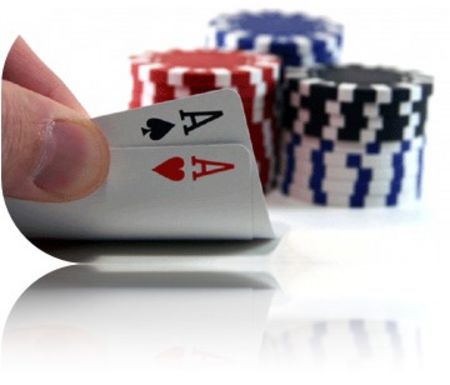Overcards

Drawing to overcards too often is a common mistake made by many players.
Overcard draws have six outs, which is approximately 7 to 1 against improving
when drawing one more card. The big problem with these types of draws is that you
are drawing to a relatively weak hand that might not win. You could be drawing
practically dead to opponents with sets, two pair, or an overpair to your overcards.
In addition, there are many ways your outs could be counterfeited. If the flop is two-
suited, two of your six outs are vulnerable to flush draws. For example, you hold the
K ♣ Q ♦ with a flop of 9 ♣ 8 ♥ 5 ♥.
The K ♥ or Q ♥ could give you a pair while giving
someone else a flush. You could also be vulnerable to straight draws. In the same
example, if a queen comes, you would lose to JT. You are also vulnerable to two
pair. Many opponents play a pair with an overcard. If someone holds a hand like K9
or K8, your out is counterfeited.
Advanced Concept: Drawing to overcards with an ace in your hand is even more risky than drawing
to a hand with a king or queen. Many opponents play hands such as Ax, so there is an increased
chance that your overcard ace could be counterfeited.
In the example above, hands like K9 and K8 are not too common unless played out
of the blinds; however, many opponents play A9, A8, and A5, especially if they are
suited. In most cases, your hand should be thrown away when you are drawing to
overcards and one of them is an ace, unless you have a specific reason to believe
that an opponent does not hold an ace The only time an ace overcard adds some
value is in heads-up situations, or possibly against two opponents, when there is
the possibility that you could win with just ace high depending on the board.
When you hit your overcard, you can also lose to opponents who have a better
kicker. For example, if you hold KJ and an opponent holds KQ, you only have three
outs to the jack. Although rare, sometimes you could be drawing dead when two
opponents counterfeit all of your outs. For example, with KJ, you are drawing dead
if your opponents hold KQ and AJ. Finally, overcards can lose to an opponent
hitting a set, backdoor flush or backdoor straight.
Let's summarize why overcard draws are especially weak and vulnerable draws:
-
Your odds are only 7 to 1 against improving when drawing one more card,
and you are drawing to a relatively weak hand.
- You could be drawing practically dead to opponents with sets, two pair, or an
overpair to your overcards.
- Your out could give an opponent a flush or straight.
- Your out could give an opponent two pair, especially when you are holding
an ace.
- Your out could give an opponent a pair with a better kicker.
- You could lose to an opponent hitting a set, backdoor flush or backdoor
straight.
As bad as all this sounds, there are times when drawing to overcards is OK, but you
must remember that these are not very strong draws. At best, drawing to overcards
is usually a marginal decision. In other words, folding or calling would be
acceptable. If you always folded overcards when you suspect an opponent has at
least a pair, you would not be giving up much at all.
Advanced concept: Drawing to overcards is a marginal decision at best, even when almost all the
conditions are perfect.
Most beginning players will save money by never drawing to overcards. For those
players who want to consider drawing to overcards, the conditions should be just
right. At a basic level, you need to be reasonably confident that you are drawing to
a winning hand and are getting sufficient pot odds to justify the draw. The problem
is that for both these criteria to be met, you need an almost perfect scenario to be
able to call.
The following discussion will look at the conditions needed to meet these two basic
criteria. The discussion assumes an opponent has bet out and you feel he has at
least a pair. It is also assumed that you have no other type of draw like a gut-shot
straight draw. There are situations when you can call or semi-bluff with overcards
against opponents who may not have anything, but these will be discussed later.
You should almost always be against a few opponents. The fewer opponents
you are against, the better chance you have to win if you improve. When you are
playing overcards against a field of four or five opponents, all the risks we
discussed about drawing to a weak hand are increased.
There is an increased chance that an opponent holds a set or two pair, or that your
outs are counterfeited.
Of course there are exceptions to when you might draw. If the pot is extremely
large, such as in a capped pot with many opponents, you can sometimes draw to
your hand. With a large pot, backdoor flush and straight opportunities might make a
call profitable.
For example, if you hold the K ♥ Q ♥
with a flop of T ♦ 7 ♥ 5 ♣, you have a chance at a
backdoor flush and backdoor straight, while also having over-cards as potential
nuts. Another heart, K, Q, or J will allow you to draw to the river. A backdoor flush
draw only has a 1 in 24 chance in succeeding (about 4% of the time), so you need
a very large pot to justify these types of draws with weak overcard outs. Adding a
backdoor straight will improve these odds slightly.
Be wary of playing when the preflop raiser is now the flop bettor or either
calling a flop bet. Remember that you need to be reasonably sure that your
overcards will win if you hit, Preflop raisers often are holding AA, KK, QQ, AK, and
AQ. When there are several opponents and the preflop raiser is betting the flop, you
should almost always fold your overcards. You are likely playing against a premium
hand and there is a good chance that you art; drawing dead. If someone bets into
the raiser and he calls, there still is a chance that the preflop raiser counterfeits
your overcards. Remember, all these scenarios assume that the bettor probably
has a hand. In heads-up situations, your strategies can be very different, which we
will discuss later.
The pot should be large. You have to be getting sufficient pot odds to justify
calling a draw that is 7 to 1 against improving. Unfortunately, this is somewhat
contradictory to the first two conditions we discussed above, It if hard to have a
large pot with only a few opponents, without a preflop raise or with a preflop raise
but the raiser folds. However, there are two scenarios when this might occur.
Sometimes a player will raise preflop and then fold against a flop bet. This might
happen when the preflop raiser had a medium pocket pair and now folds to a bet on
the flop. In this case, the pot might be large enough to justify a call to your
overcards.
The other scenario when the pot could be large enough to call is when there are
several players who call preflop with no raise, and then two or three players call the
flop. For example, three players limp in along with the small blind and big blind. The
small blind bets, an early player calls, the cutoff calls, and you are acting last on the
button. There are now eight bets in the pot that might justify calling: however, this is
still a marginal call since you need to discount your outs.
Generally only play for one bet. You should almost never call raises or face the
risk of a raise unless the pot is exceptionally large. Generally this means that your
call will close the betting or you are acting next to last.
The flop should be favorable so that there is less risk that your outs are
counterfeited. Generally fold when the flop type increases the risk that your outs
are counterfeited. For example, three-suited, two-suited, three-connected, two
connected high cards, a high pair, or all high cards are all dangerous flops for
overcard draws.
Let's look at which types of flops can sometimes be played with overcard draws
under the right conditions.
NEXT...Dangerous Flops2

